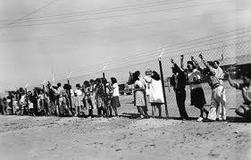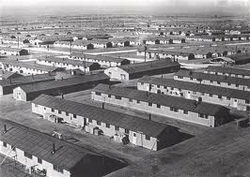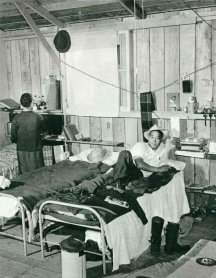Being put to the internment was life-changing......
As the Japanese-Americans were interned to different locations throughout the United States, they faced many hardships and and upraised questions about the rights of American citizens as expressed in the first ten amendments to the Constitution. They faced problems in their family, surrounding, and many more.
The movement of the population into the camps began in March and continued through November, 1942… (“Historic Perspectives” page 5 paragraphs 1)”. Since most of the Japanese Americans had no kind of crime done, it was not fair that they were relocated to camps that were where they died. With all these problems going on, it makes sense that they were emotionally stressed and had other problems in the camps that they were held in.(www.wikipedia.org/wiki/Japanese_American_internment)
The Japanese-American had to live in "tar paper-covered barracks of simple frame construction without plumbing or cooking facilities of any kind." Each internment camp was overcrowded with miserable,sorrowful people since over 120,000 Japanese-Americans were distributed to only 10 internment camps. Take for example, for food, they had to stand in extensive lines for a little amount of food and eat off tin pie plates in big mess halls with a lot of other strangers. They were fed government commodity foods and castoff meat from Army surplus — hot dogs, ketchup, kidneys, Spam and potatoes. The Japanese diet and family table were erased” ( “Food and the Japanese Internment”). Temperature was another additional problem to the people since most of the internment camps were in hot desert areas. The average summer temperatures were over 100 degrees. The evacuation destroyed many people’s lives and made them suffer. The internment, ostensibly to protect against possible sabotage and espionage, moreover included babies, orphans, adopted children, and the infirm or bedridden elderly. Children of mixed blood, even from orphanages, were included if they had any Japanese ancestry at all (Weber). The babies and the elderly, of course, faced many problems involving health. Take for example, Sue Tokushige was a young mother of 20, with a 10-day-old baby, when she was sent to a relocation camp in Arizona with her husband. She said the government did not supply milk for her baby, and since she was unable to breastfeed, she fed her daughter only water for 10 days and her daughter still pays for it today as she face health problems (Myers). Some Japanese also died in camps because of insufficient medicinal care, the emotional traumas or stresses they have encountered, and a lot of other people were killed by military guards displayed for not following orders.
The movement of the population into the camps began in March and continued through November, 1942… (“Historic Perspectives” page 5 paragraphs 1)”. Since most of the Japanese Americans had no kind of crime done, it was not fair that they were relocated to camps that were where they died. With all these problems going on, it makes sense that they were emotionally stressed and had other problems in the camps that they were held in.(www.wikipedia.org/wiki/Japanese_American_internment)
The Japanese-American had to live in "tar paper-covered barracks of simple frame construction without plumbing or cooking facilities of any kind." Each internment camp was overcrowded with miserable,sorrowful people since over 120,000 Japanese-Americans were distributed to only 10 internment camps. Take for example, for food, they had to stand in extensive lines for a little amount of food and eat off tin pie plates in big mess halls with a lot of other strangers. They were fed government commodity foods and castoff meat from Army surplus — hot dogs, ketchup, kidneys, Spam and potatoes. The Japanese diet and family table were erased” ( “Food and the Japanese Internment”). Temperature was another additional problem to the people since most of the internment camps were in hot desert areas. The average summer temperatures were over 100 degrees. The evacuation destroyed many people’s lives and made them suffer. The internment, ostensibly to protect against possible sabotage and espionage, moreover included babies, orphans, adopted children, and the infirm or bedridden elderly. Children of mixed blood, even from orphanages, were included if they had any Japanese ancestry at all (Weber). The babies and the elderly, of course, faced many problems involving health. Take for example, Sue Tokushige was a young mother of 20, with a 10-day-old baby, when she was sent to a relocation camp in Arizona with her husband. She said the government did not supply milk for her baby, and since she was unable to breastfeed, she fed her daughter only water for 10 days and her daughter still pays for it today as she face health problems (Myers). Some Japanese also died in camps because of insufficient medicinal care, the emotional traumas or stresses they have encountered, and a lot of other people were killed by military guards displayed for not following orders.
"It was really cruel and harsh to pack and evacuate in forty-eight hours was an impossibility.Seeing mother completely bewildered with children crying from want and peddlers taking advantage and offering prices next
to robbery made me feel like murdering those responsible without the
slightest compunction in my heart."
Joseph Yoshisuke Kurihara speaking of the Terminal Island evacuation.
These were the two questions they asked you if you were 17 and up they called it "Loyalty questions" 1.
Are you willing to serve in the armed forces of the United States on
combat duty wherever ordered? (Females were asked if they were willing
to volunteer for the Army Nurse Corps or Women's Army Corps.)
2. Will you swear unqualified allegiance to the United States of America and faithfully defend the United States from any or all attack by foreign or domestic forces and forswear any form of allegiance or obedience to the Japanese emperor, to any other foreign government, power or organization?
2. Will you swear unqualified allegiance to the United States of America and faithfully defend the United States from any or all attack by foreign or domestic forces and forswear any form of allegiance or obedience to the Japanese emperor, to any other foreign government, power or organization?



